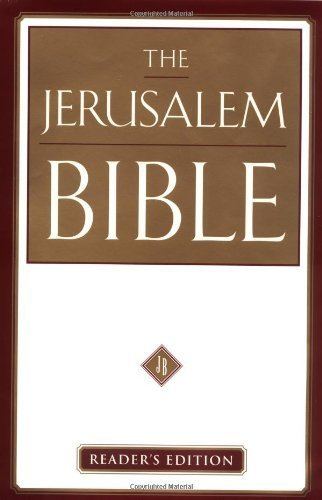9 /10 1 Votes9
Originally published 1967 | 4.5/5 Goodreads Abbreviation JB or TJB Complete Bible published 1966 | |||||||||||||||||||||||||||||||||
 | ||||||||||||||||||||||||||||||||||
Textual basis Old Testament: La Bible de Jerusalem, Masoretic text with strong Septuagint (especially in Psalms) and some Vulgate influence. New Testament: La Bible de Jérusalem, Eclectic text with high correspondence to the Nestle-Aland Novum Testamentum Graece with major variant readings from the Majority text and sacred tradition (i.e. Comma Johanneum and the longer ending of Mark) incorporated or noted. Deuterocanon: Septuagint with Vulgate influence. Translation type dynamic equivalence with a highly polished style. Copyright 1966, 1967 and 1968 by Darton, Longman & Todd Ltd and Doubleday and Co. Inc. Similar Reina‑Valera, Catholic Bible, New Living Translation, New International Version, New Jerusalem Bible | ||||||||||||||||||||||||||||||||||
Jerusalem bible reader s edition non catholic review
The Jerusalem Bible (JB or TJB) is an English-language translation of the Bible that was first introduced to the English-speaking public in 1966 and published by Darton, Longman & Todd. As a Catholic Bible, it includes the traditional 73 books found in most English translations until the mid 19th century: the 39 books shared with the Hebrew Bible, along with the seven deuterocanonical books as the Old Testament, and the 27 books shared by all Christians as the New Testament. It also contains copious footnotes and introductions.
Contents
- Jerusalem bible reader s edition non catholic review
- History
- The translation
- Translation of the tetragrammaton
- Updates
- References
The Jerusalem Bible is the basis of the Lectionary for Mass used in Catholic worship throughout England, Wales, and the majority of the English-speaking world outside the United States and Canada, though the Catholic Bishops' Conference of England and Wales has approved other translations for conditional liturgical use.
History
In 1943 Pope Pius XII issued an encyclical letter, Divino afflante Spiritu, which encouraged Roman Catholics to translate the Scriptures from the Hebrew and Greek texts, rather than from Jerome's Latin Vulgate. As a result, a number of Dominicans and other scholars at the École Biblique in Jerusalem translated the scriptures into French. The product of these efforts was published as La Bible de Jérusalem in 1956.
This French translation served as the impetus for an English translation in 1966, the Jerusalem Bible. For the majority of the books, the English translation was a translation of the Hebrew and Greek texts; in passages with more than one interpretation, the interpretation chosen by the French translators is generally followed. For a small number of Old Testament books, the first draft of the English translation was made directly from the French, and then the General Editor produced a revised draft by comparing this word-for-word to the Hebrew or Aramaic texts. The footnotes and book introductions are almost literal translations from the French.
The translation
The translation itself has been admired for its literary qualities, perhaps in part due to its most famous contributor, J. R. R. Tolkien (his primary contribution was the translation of Jonah). It is commonly held that the Jerusalem Bible was not a translation from the French; rather, it was an original translation heavily influenced by the French. This view is not shared by Henry Wansbrough, editor of the New Jerusalem Bible, who writes, "Despite claims to the contrary, it is clear that the Jerusalem Bible was translated from the French, possibly with occasional glances at the Hebrew or Greek, rather than vice versa."
The dynamic equivalence of the translation is more "thought-for-thought" than "word-for-word" compared to other modern translations. The introductions, footnotes, and even the translation itself reflect a modern scholarly approach and the conclusions of scholars who use historical-critical method. As examples, the introduction and notes reject Moses' authorship of the Pentateuch, as well as the Book of Wisdom having been authored by King Solomon.
The Jerusalem Bible was the first widely accepted Roman Catholic English translation of the Bible since the Douay-Rheims Version of the 17th century. It has also been widely praised for an overall very high level of scholarship, and is widely admired and sometimes used by liberal and moderate Protestants. The Jerusalem Bible is one of the versions authorized to be used in services of the Episcopal Church and the Anglican Communion.
Translation of the tetragrammaton
The Jerusalem Bible returned to the use of the historical name Yahweh as the name of God in the Old Testament, rendered as such in 6,823 places within this translation. The move has been welcomed by some; however, it has not been popular among groups who would prefer the name of God be left unpronounced, or substituted with Lord or another title.
On 29 June 2008, Cardinal Francis Arinze, Prefect of the Congregation for Divine Worship and the Discipline of the Sacraments, wrote to the presidents of all conferences of bishops at the behest of Pope Benedict XVI, stating that the use of the name Yahweh was to be dropped from Catholic Bibles in liturgical use, (most notably the CTS New Catholic Bible, which uses the Jerusalem Bible text) as well as from songs and prayers, since pronunciation of this name violates long-standing Jewish and Christian tradition.
